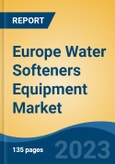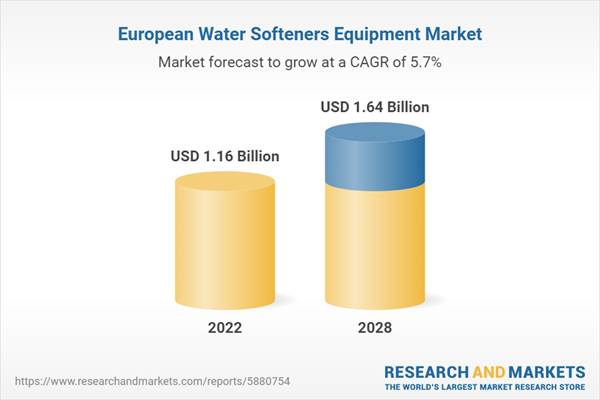Speak directly to the analyst to clarify any post sales queries you may have.
10% Free customizationThis report comes with 10% free customization, enabling you to add data that meets your specific business needs.
Water is softened by eliminating metal components like calcium and magnesium from hard water. Magnesium ions, calcium ions, and other types of metallic cations are removed from hard water using water-softening equipment. Ion exchange resins, lime softeners, reverse osmosis membranes, nanofiltration, etc. are regularly used to remove pollutants and contaminants from water to reduce water hardness, which is frequently caused by these chemicals.
Hard minerals with mineral deposits limit heat transfer and increase the possibility of boiler tubes breaking. Using soft water would reduce the amount of additional soap and detergent needed for cleaning and washing, which helps to increase the lifespan of electrical appliances including water heaters, dishwashers, and washing machines. The mineral tank, brine tank, and control valve makeup the water-softening system's three parts. The above three work together & help to maintain & repair the system, remove minerals from hard water and monitor the flow of water on a regular basis. A water softener eliminates the need to fix corroded, flaky and worn-out water heaters and tap heads as well as considerably decreases the time required to remove soap scum.
The Europe region follows a similar path to that which the USA has followed in the evolution of drinking water disinfection. At the end of the nineteenth century or the start of the twentieth century, most European nations started disinfecting their drinking water & chlorine was widely used across the region. .It is introduced to water as sodium hypochlorite, calcium hypochlorite, or chlorine gas. Ozone is used for taste and odour control. In most situations, chlorine is used as a major disinfectant to produce drinking water from surface water. Chlorine is frequently the sole appropriate disinfectant for the simpler treatment method of treating groundwater. Alternative disinfectants are also used throughout Europe to disinfect drinking water. France, for instance, mostly employs ozone. Ozone was first used to clean drinking water in 1906. Ozone or chlorine dioxide are used as principal oxidants and disinfectants in Germany and Italy. To provide residual disinfection, chlorine is used. One of the few European nations, Great Britain uses chloramines to remove disinfection byproducts and provide residual disinfection in the distribution system. Chloramines are occasionally used for disinfection in Finland, Spain, and Sweden.
Growing awareness of consumers regarding the negative health impacts of hard water
Human health is significantly negatively impacted by hard water. For instance, if hard water had an adverse effect on human skin due to the high concentration of minerals contained in it, it would be detrimental to the body's delicate skin. Hard water's mineral content can clog skin pores, leaving them constantly dry and irritated. Delicate water is significantly more kind on the skin and aids in preserving the PH balance of your soft, smooth skin. Because of this, water-softening treatments are employed to improve its quality and make it suitable for human consumption.Additionally, because hard water is polluted and contains dangerous minerals that are not suitable for eating, it is not appropriate for cooking or drinking. For these reasons, water treatment products are typically used at home to cure hard water. As a result, these elements will benefit the water softener industry in Europe during the upcoming years.
Hard water impacts the life of automobiles.
Even automobiles can suffer damage from deposits or residue from hard water, in addition to clothing and dishes. Because hard water contains limescale, which also reduces the paint's natural sheen, the number of streaks and stains on cars increases. It will not take long for the car to start looking older than it is. This is why it is often recommended to wash scooters and cars in soft water. There is a demand for a water softener solution that increases the lifespan of automobiles due to the damage that hard water can inflict on everyday items. The market growth for water Softeners Equipment is expected to be fuelled by these reasons in the upcoming years.
Market Segmentation
The Europe Water Softeners Equipment market can be segmented by type, product, and end use and by region. Based on type, the market can be segmented into electric and non-electric. Based on the product, the market can be differentiated into salt-based and salt-free. Based on end use, the market can be grouped into residential, commercial, and industrial.Market Players
Cumulus Nederland BV, Delta Water Technologies and Systems, Hatenboer-Water BV, Kinetico UK Ltd., LENNTECH, Lubron Water treatment, Pentair PLC, Pollet Water Group, Veolia Group, BWT Holding GmbH, are some of the leading players operating in the Europe water Softeners Equipment Market.Report Scope:
In this report, the Europe Water Softeners Equipment market has been segmented into the following categories, in addition to the industry trends which have also been detailed below:Europe Water Softeners Equipment Market, By Type:
- Electric
- Non-Electric
Europe Water Softeners Equipment Market, By Product:
- Salt-Based
- Salt-Free
Europe Water Softeners Equipment Market, By End User:
- Residential
- Commercial
- Industrial
Europe Water Softeners Equipment Market, By Region:
- Netherlands
- France
- United Kingdom
- Italy
- Germany
- Spain
- Portugal
- Poland
Competitive Landscape
Company Profiles: Detailed analysis of the major companies present in the Europe Water Softeners Equipment Market.Available Customizations:
With the given market data, the publisher offers customizations according to a company’s specific needs.This product will be delivered within 1-3 business days.
Table of Contents
Companies Mentioned
- Cumulus Nederland BV
- Delta Water Technologies and Systems
- Hatenboer-Water BV
- Kinetico UK Ltd
- Lenntech
- Lubron Water treatment
- Pentair PLC
- Pollet Water Group
- Veolia Group
- BWT Holding GmbH
Table Information
| Report Attribute | Details |
|---|---|
| No. of Pages | 135 |
| Published | September 2023 |
| Forecast Period | 2022 - 2028 |
| Estimated Market Value ( USD | $ 1.16 Billion |
| Forecasted Market Value ( USD | $ 1.64 Billion |
| Compound Annual Growth Rate | 5.7% |
| Regions Covered | Europe |
| No. of Companies Mentioned | 10 |









